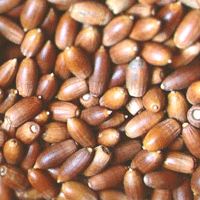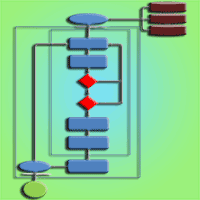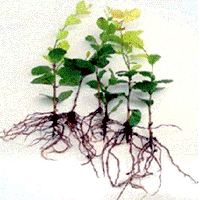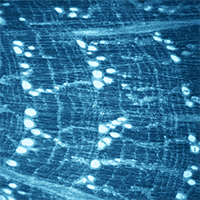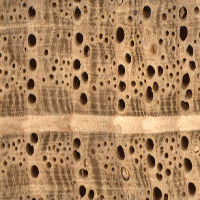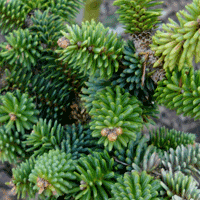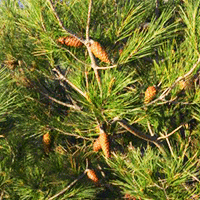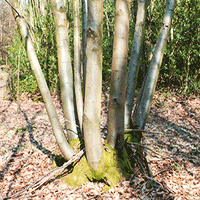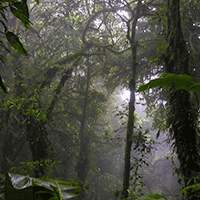In the woodlands of Sardinia, as in many other areas of the Mediterranean region, grazing of domestic animals is still very common, though often in the absence of any sustainable management logic or technique. The present work analyzes the effects of excessive grazing pressure on a wooded pasture in the municipality of Orgosolo (Nuoro province), emphasizing the effects on the natural regeneration of the oak species (Quercus ilex and Quercus pubescens). This study has revealed the positive effects of the interaction between shrubs and seedlings of tree species. Crataegus monogyna proved to be the most efficient shrub species in favouring the establishment and growth of saplings; Rubus ulmifolius is efficient in the establishing phase but somewhat less so in the following stages. The other shrub species (Prunus spinosa, Genista pichi-sermolliana, Stachys glutinosa) play a lesser facilitating role. Despite the fact that seedlings are found in more than half (56%) of the shrub patches, the average age of the seedlings (14±0.6 yrs) and their small average size (height 24±1.4cm) lead to think that the present grazing pressure is incompatible with any concrete chance of success for their natural regeneration.
Keywords
, , ,
Citation
Alias S, Bianchi L, Calamini G, Gregori E, Sioni S (2010). Shrub facilitation of Quercus ilex and Quercus pubescens regeneration in a wooded pasture in central Sardinia (Italy). iForest 3: 16-22. - doi: 10.3832/ifor0517-003
Academic Editor
Renzo Motta
Paper history
Received: Mar 02, 2009
Accepted: Sep 24, 2009
First online: Jan 22, 2010
Publication Date: Jan 22, 2010
Publication Time: 4.00 months
© SISEF - The Italian Society of Silviculture and Forest Ecology 2010
Open Access
This article is distributed under the terms of the Creative Commons Attribution-Non Commercial 4.0 International (https://creativecommons.org/licenses/by-nc/4.0/), which permits unrestricted use, distribution, and reproduction in any medium, provided you give appropriate credit to the original author(s) and the source, provide a link to the Creative Commons license, and indicate if changes were made.

Breakdown by View Type
(Waiting for server response...)
Article Usage
Total Article Views: 57877
(from publication date up to now)
Breakdown by View Type
HTML Page Views: 48370
Abstract Page Views: 3841
PDF Downloads: 4629
Citation/Reference Downloads: 27
XML Downloads: 1010
Web Metrics
Days since publication: 5795
Overall contacts: 57877
Avg. contacts per week: 69.91
Article Citations
Article citations are based on data periodically collected from the Clarivate Web of Science web site
(last update: Mar 2025)
Total number of cites (since 2010): 12
Average cites per year: 0.75
Publication Metrics
by Dimensions ©
Articles citing this article
List of the papers citing this article based on CrossRef Cited-by.
(1)
Alias S, Bianchi L, Calamini G, Campus S, Gregori G (2008)Pascoli arborati in Sardegna. Un caso in provincia di Nuoro. Sherwood 141: 15-19.
Gscholar
(2)
Arrigoni PV (1968)Fitoclimatologia della Sardegna. Webbia 23: 1-100.
Gscholar
(3)
Bakker ES, Olff H, Vandenberghe C, de Maeyer K, Smit R, Gleichman JM, Vera FWM (2004)Ecological anachronisms in the recruitment of temperate light-demanding tree species in wooded pastures. Journal of Applied Ecology 41: 571-582.
CrossRef |
Gscholar
(4)
Barik SK, Tripathi RS, Pandey HN, Rao P (1996)Tree regeneration in a subtropical humid forest: effect of cultural disturbance on seed production, dispersal and germination. Journal of Applied Ecology 33 (6): 1551-1560.
CrossRef |
Gscholar
(5)
Bellocq MI, Jones C, Dey DC, Turgeon JJ (2005)Does the shelterwood method to regenerate oak forest affect acorn production and predation? Forest Ecology and Management 205: 311-323.
CrossRef |
Gscholar
(6)
Bernetti G (1995)Selvicoltura Speciale
. UTET Editore, Torino, Italy.
Gscholar
(7)
Bertness MD, Callaway R (1994)Positive interactions in communities. Trends in Ecology & Evolution 9 (5): 191-193.
CrossRef |
Gscholar
(8)
Bianchi L, Calamini G, Gregori E, Zorn G (2003)Valutazione degli effetti del rimboschimento in zone aride della Sardegna. Inquadramento climatico delle aree sperimentali. Italia Forestale e Montana 5: 389-407.
Gscholar
(9)
Bossema I (1979)Jays and oaks: an eco-ethological study of a symbiosis. Behaviour 70: 1-17.
CrossRef |
Gscholar
(10)
Buckley DS, Sharik TL, Isebrands JG (1998)Regeneration of northern red oak: positive and negative effects of competitor removal. Ecology 79 (1): 65-78.
CrossRef |
Gscholar
(11)
Callaway RM (1992)Effect of shrubs on recruitment of
Quercus douglasii and
Quercus lobata in California. Ecology 73 (6): 2118-2128.
CrossRef |
Gscholar
(12)
Callaway RM, D’Antonio CM (1991)Shrub facilitation of coast live oak establishment in central California. Madrono 38 (3): 158-169.
Gscholar
(13)
Callaway R, Walker LR (1997)Competition and facilitation: a synthetic approach to interactions in plant communities. Ecology 78 (7): 1958-1965.
CrossRef |
Gscholar
(14)
Callaway RM (1998)Are positive interactions species-specific? Oikos 82 (1): 202-207.
Online |
Gscholar
(15)
Callaway RM, Davis FW (1998)Recruitment of
Quercus agrifolia in central California: the importance of shrub-dominated patches. Journal of Vegetation Science 9 (5): 647-656.
CrossRef |
Gscholar
(16)
Camarda I (1993)Montagne di Sardegna. Carlo Delfino editore, Sassari, Italy.
Gscholar
(17)
Campus S (2005)Il bosco di Pradu, Orgosolo (NU). B. Sc. Thesis in Forest and Environmental Sciences, DISTAF, Università di Firenze, Italy.
Gscholar
(18)
Castro J, Zamora R, HÏdar JA, GÏmez JM, GÏmez-Aparicio L (2004)Benefits of using shrubs as nurse plants for reforestation in mediterranean mountains: a 4-year study. Restoration Ecology 12 (3): 352-358.
CrossRef |
Gscholar
(19)
Castro J, Zamora R, Hódar JA (2006)Restoring
Quercus pyrenaica forests using pioneer shrubs as nurse plants. Applied Vegetation Science 9: 137-142.
CrossRef |
Gscholar
(20)
Chambers JC (2001)Pinus monophylla establishment in an expanding pinus-juniperus woodland: environmental conditions, facilitation and interacting factors. Journal of Vegetation Science 12: 27-40.
CrossRef |
Gscholar
(21)
Cierjacks A, Hensen I (2004)Variation of stand structure and regeneration of Mediterranean holm oak along a grazing intensity gradient. Plant Ecology 173: 215-223.
CrossRef |
Gscholar
(22)
Crawley MJ, Long CR (1995)Alternate bearing, predator satiation and seedling recruitment in
Quercus robur l. The Journal of Ecology 83 (4): 683-696.
CrossRef |
Gscholar
(23)
Debussche M, Isenmann P (1994)Bird-dispersed seed rain and seedling establishment in patchy Mediterranean vegetation. Oikos, 69 (3): 414-426.
CrossRef |
Gscholar
(24)
Diaz M, Pulido FJ, Marañon T (2003)Diversidad biológica y sostenibilidad ecológica y económica de los sistemas adehesados. Ecosistemas 2003
Gscholar
(25)
Dufour-Dror JM (2007)Influence of cattle grazing on the density of oak seedlings and saplings in a tabor oak forest in Israel. Acta Oecologica 3 (1): 223-228.
CrossRef |
Gscholar
(26)
Franco-Pizaña JG, Fulbright TE, Gardiner DT, Tipton AR (1996)Shrub emergence and seedling growth in micro environments created by
Prosopis glandulosa. Journal of Vegetation Science 7 (2): 257-264.
CrossRef |
Gscholar
(27)
Gill RMA (1992)A review of damage by mammals in north temperate forests: 3. Impact on trees and forests. Forestry 65: 363-388.
CrossRef |
Gscholar
(28)
Gómez-Aparicio L, Gómez JM, Zamora R, Boettinger JL (2005a)Canopy
vs. Soil effects of shrubs facilitating tree seedlings in mediterranean montane ecosystems. Journal of Vegetation Science 16: 191-198.
CrossRef |
Gscholar
(29)
Gómez-Aparicio L, Valladares F, Zamora R, Quero JL (2005b)Response of tree seedlings to the abiotic heterogeneity generated by nurse shrubs: an experimental approach at different scales. Ecography 28: 757-768.
CrossRef |
Gscholar
(30)
Gómez-Aparicio L, Gómez JM, Zamora R (2005c)Microhabitats shift rank in suitability for seedling establishment depending on habitat type and climate. Journal of Ecology 93: 1194-1202.
CrossRef |
Gscholar
(31)
Gómez JM, Hódar JA, Zamora R, Castro J, García D (2001)Ungulate damage on Scots pines in mediterranean environments: effects of association with shrub. Can. J. Bot. 79 (6): 739-746.
CrossRef |
Gscholar
(32)
Herrera J (1995)Acorn predation and seedling production in a low-density population of Cork oak (
Quercus suber l.). Forest Ecology and Management 76: 197-201.
CrossRef |
Gscholar
(33)
Joffre R, Vacher J, De Los Llanos, Long G (1988)The dehesa: an agrosilvopastoral system of the Mediterranean region whit special reference to the Sierra Morena area of Spain. Agroforestry System 6: 71-96.
Gscholar
(34)
Joffre R, Rambal S, Ratte JP (1999)The dehesa system of southern Spain and Portugal as a natural ecosystem mimic. Agroforestry Systems 45: 57-79.
CrossRef |
Gscholar
(35)
Kuiters AT, Slim PA (2003)Tree colonisation of abandoned arable land after 27 years of horse-grazing: the role of bramble as a facilitator of oak wood regeneration. Forest Ecology and Management 181: 239-251.
CrossRef |
Gscholar
(36)
Kunstler G, Curt T, Bouchaud M, Lepart J (2006)Indirect facilitation and competition in tree species colonization of sub-mediterranean grasslands. Journal of Vegetation Science 17: 379-388.
CrossRef |
Gscholar
(37)
Leiva MJ, Fernández-Alés R (2003)Post-dispersive losses of acorn from mediterranean Savanna-like forests and shrublands. Forest Ecology and Management 176: 265-271.
CrossRef |
Gscholar
(38)
Linares AM (2007)Forest planning and traditional knowledge in collective woodlands of Spain: the dehesa system. Forest Ecology and Management 249: 71-79.
CrossRef |
Gscholar
(39)
Madrau S (1995)Valutazione della attitudine all’utilizzo forestale dei suoli della Sardegna. L’area del parco del Gennargentu. Annali Accademia Italiana di Scienze Forestali 44: 279-305.
Gscholar
(40)
Mitchell FJG, Kirby KJ (1990)The impact of large herbivores on the conservation of semi-natural woods in the British uplands Forestry 63: 333- 353.
CrossRef |
Gscholar
(41)
Munoz DC (2004)Algunos apuntes para la conservaciòn de las dehesas. Escuela Tecnica Superior De Ingeneros Agronomos Y De Montes. Univeridad De Cordoba, Spain.
Gscholar
(42)
Peco B, Sánchez AM, Azcárate FM (2006)Abandonment in grazing systems: consequences for vegetation and soil. Agriculture, Ecosystems and Environment 113: 284-294.
CrossRef |
Gscholar
(43)
Perevolotsky A, Seligman NG (1998)Role of grazing in mediterranean rangeland ecosystem. Bioscience 48 (12): 1007-1017.
CrossRef |
Gscholar
(44)
Plieninger T (2005)Compatibility of livestock grazing with stand regeneration in mediterranean holm oak park lands. Journal for Nature Conservation 15: 1-9.
CrossRef |
Gscholar
(45)
Plieninger T, Modolell Y, Mainou J, Konold W (2004)Land manager attitudes toward management, regeneration, and conservation of Spanish holm oak Savannas (Dehesas). Landscape and Urban Planning 66: 185-198.
CrossRef |
Gscholar
(46)
Pulido FJ (2002)Biología reproductiva y conservación: el caso de la regeneración de bosques templados y subtropicales de robles (
Quercus spp.). Rev. Chil. Hist. Nat
. 75 (1): 5-15.
CrossRef |
Gscholar
(47)
Pulido FJ, Díaz M, Hidalgo De Trucios SJ (2001)Size structure and regeneration of Spanish holm oak
Quercus ilex forests and dehesas: effects of agroforestry use on their long-term sustainability. Forest Ecology and Management 146: 1-13.
CrossRef |
Gscholar
(48)
Rivas-Martínez S, Rivas-Sáenz S (2008)Sistema de clasificación bioclimática mundial, 1996-2009, Centro de Investigaciones Fitosociológicas, España.
Online |
Gscholar
(49)
Rousset O, Lepart J (1999)Shrub facilitation of
Quercus humilis regeneration in succession on calcareous grasslands. Journal of Vegetation Science 10 (4): 493-502.
CrossRef |
Gscholar
(50)
Rousset O, Lepart J (2000)Positive and negative interactions at different life stages of a colonizing species (
Quercus humilis). Journal of Ecology 88: 401-412.
CrossRef |
Gscholar
(51)
Shaw MW (1968)North Wales: A preliminary study of acorn production, viability and losses. The Journal of Ecology 56 (2): 565-583.
CrossRef |
Gscholar
(52)
Smit C, Béguin D, Buttler A, Müller-Schärer H (2005)Safe sites for tree regeneration in wooded pastures: a case of associational resistance? Journal of Vegetation Science 16: 209-214.
CrossRef |
Gscholar
(53)
Smit C, Gusberti M, Müller-Schärer H (2006)Safe for saplings; safe for seeds? Forest Ecology and Management 237: 471-477.
CrossRef |
Gscholar
(54)
Smit C, Vandenberghe C, Den Ouden J, Müller-Schärer H (2007)Nurse plants, tree saplings and grazing pressure: changes in facilitation along a biotic environmental gradient. Oecologia 152: 265-273.
CrossRef |
Gscholar
(55)
Soil Survey Staff (2006)Keys to soil taxonomy (10
th edn). United States Department of Agriculture, Natural Resources Conservation Service.
Gscholar
(56)
Sork VL, Bramble J, Sexton O (1993)Ecology of mast-fruiting in three species of north American deciduous oaks. Ecology 74 (2): 528-541.
CrossRef |
Gscholar
(57)
Todd SW, Hoffman MT (1999)A fence-line contrast reveals effects of heavy grazing on plant diversity and community composition in Namaqualand, South Africa. Plant Ecology 142: 169-178.
CrossRef |
Gscholar
(58)
Vesk PA, Westoby M (2001)Predicting plant species’ responses to grazing. Journal of Applied Ecology 38: 897-909.
CrossRef |
Gscholar
(59)
Williams K, Westrick LJ, Williams BJ (2006)Effects of blackberry (
Rubus discolor) invasion on oak population dynamics in a California savanna. Forest Ecology and Management 228: 187-196.
CrossRef |
Gscholar


